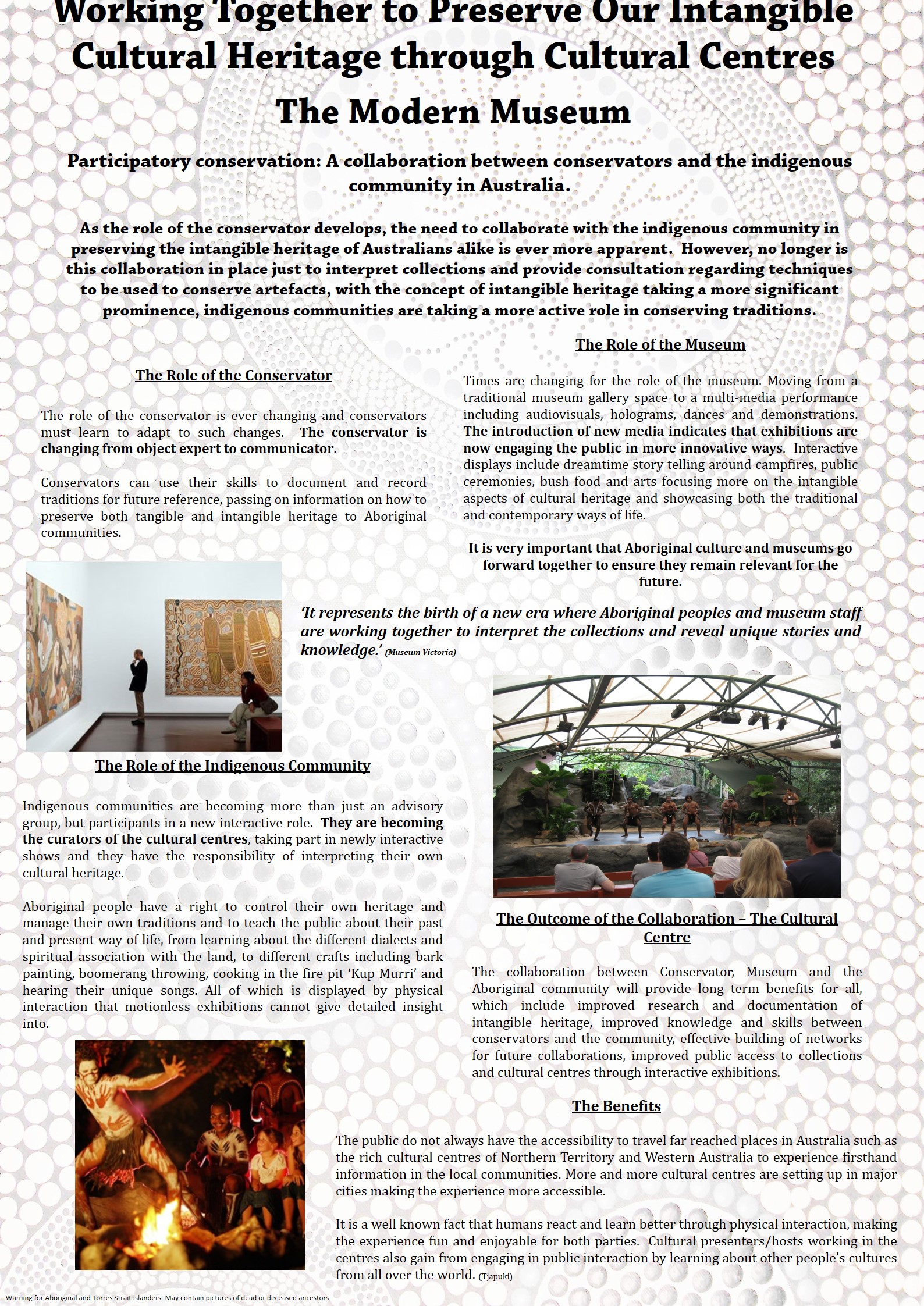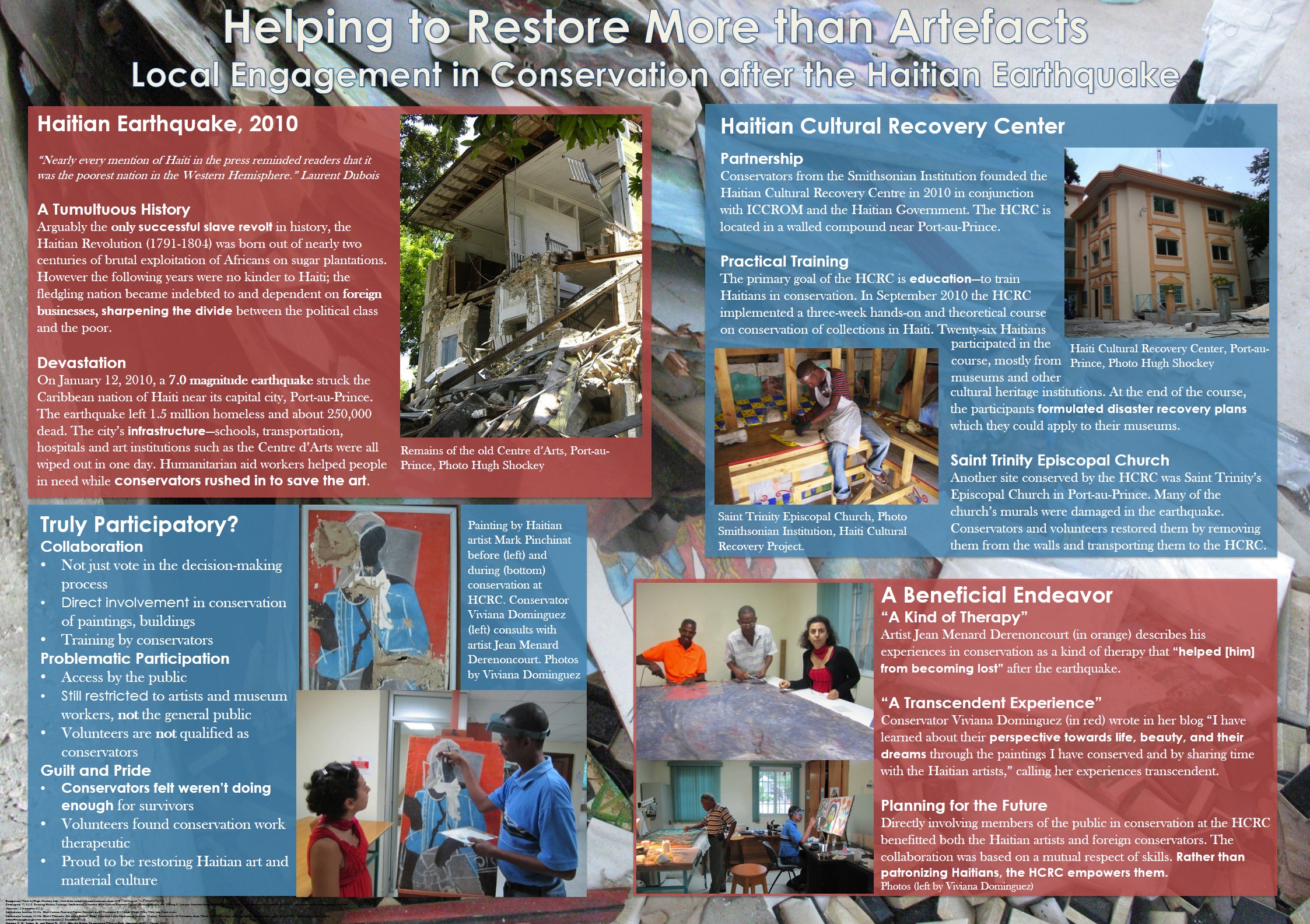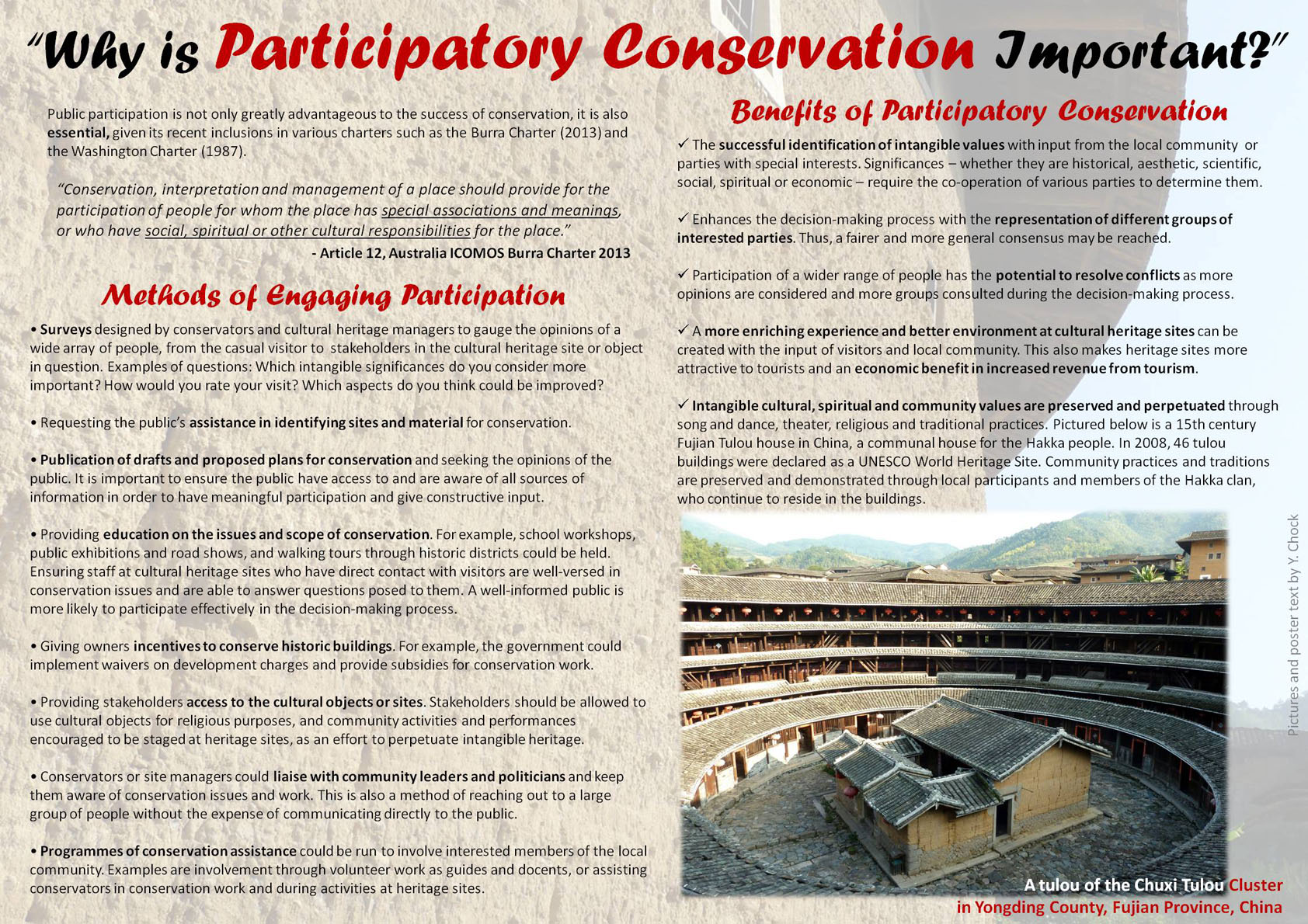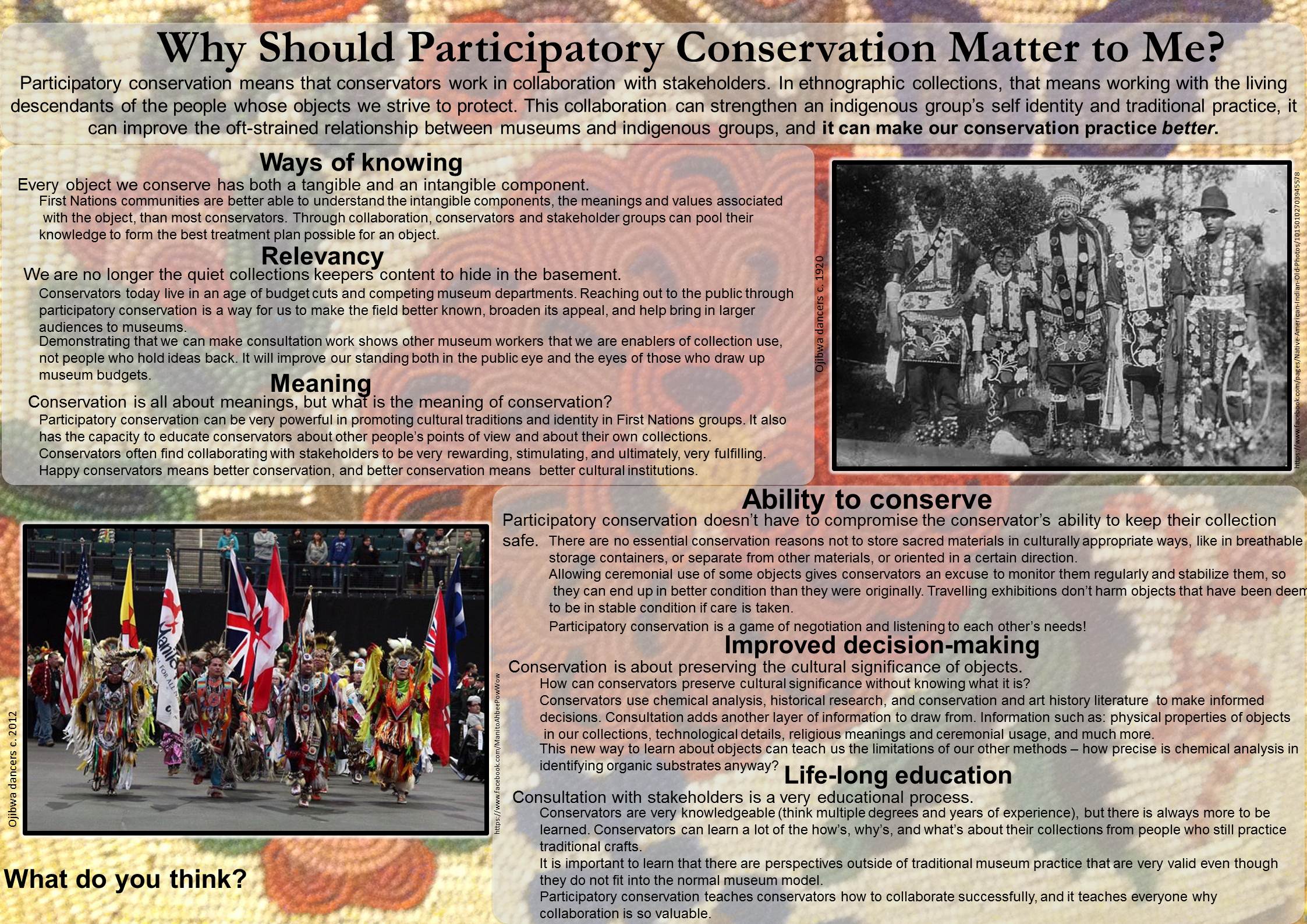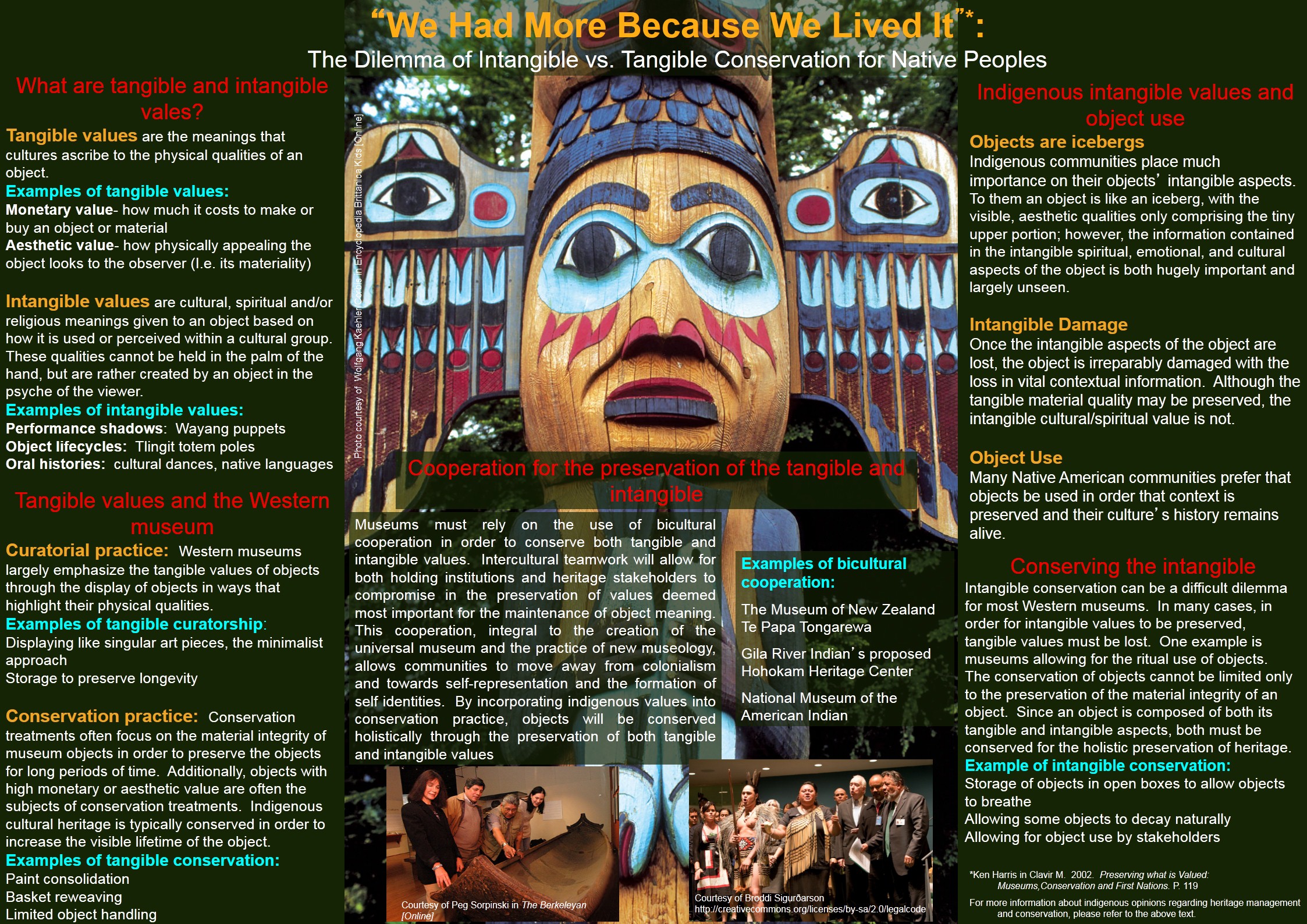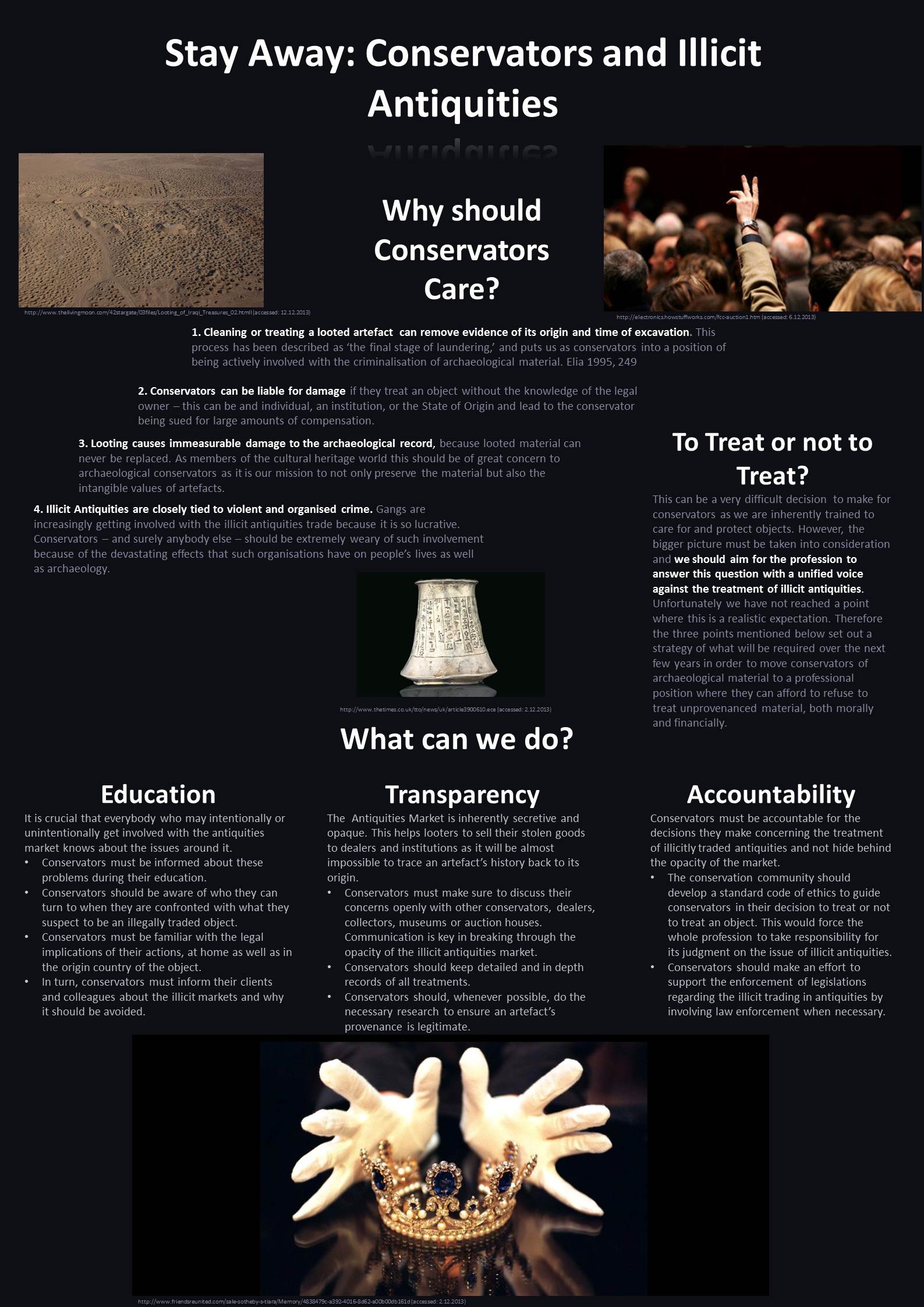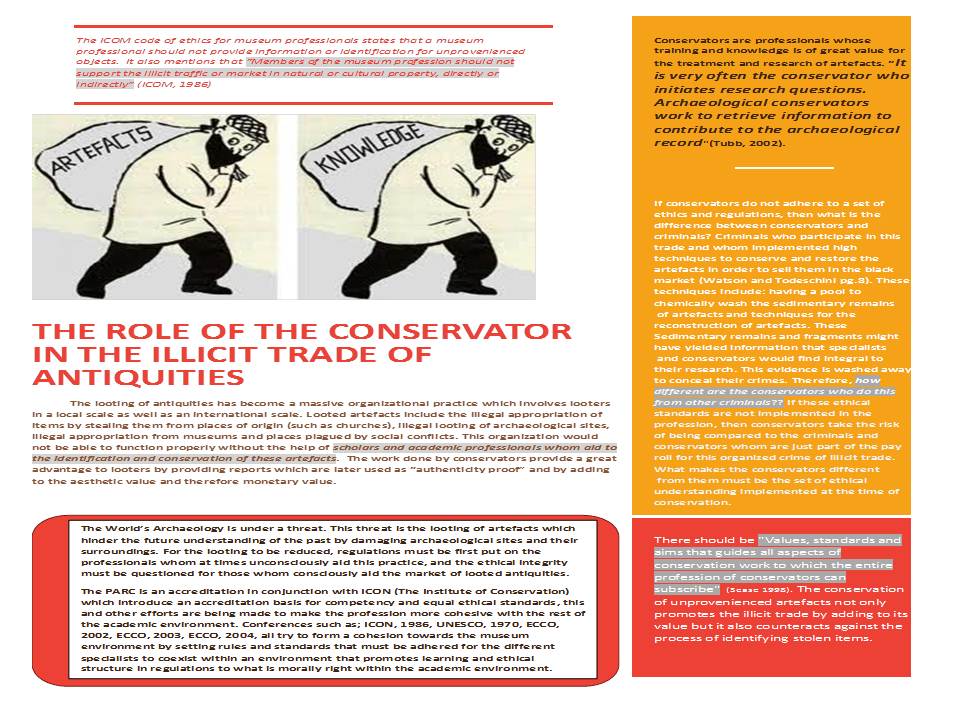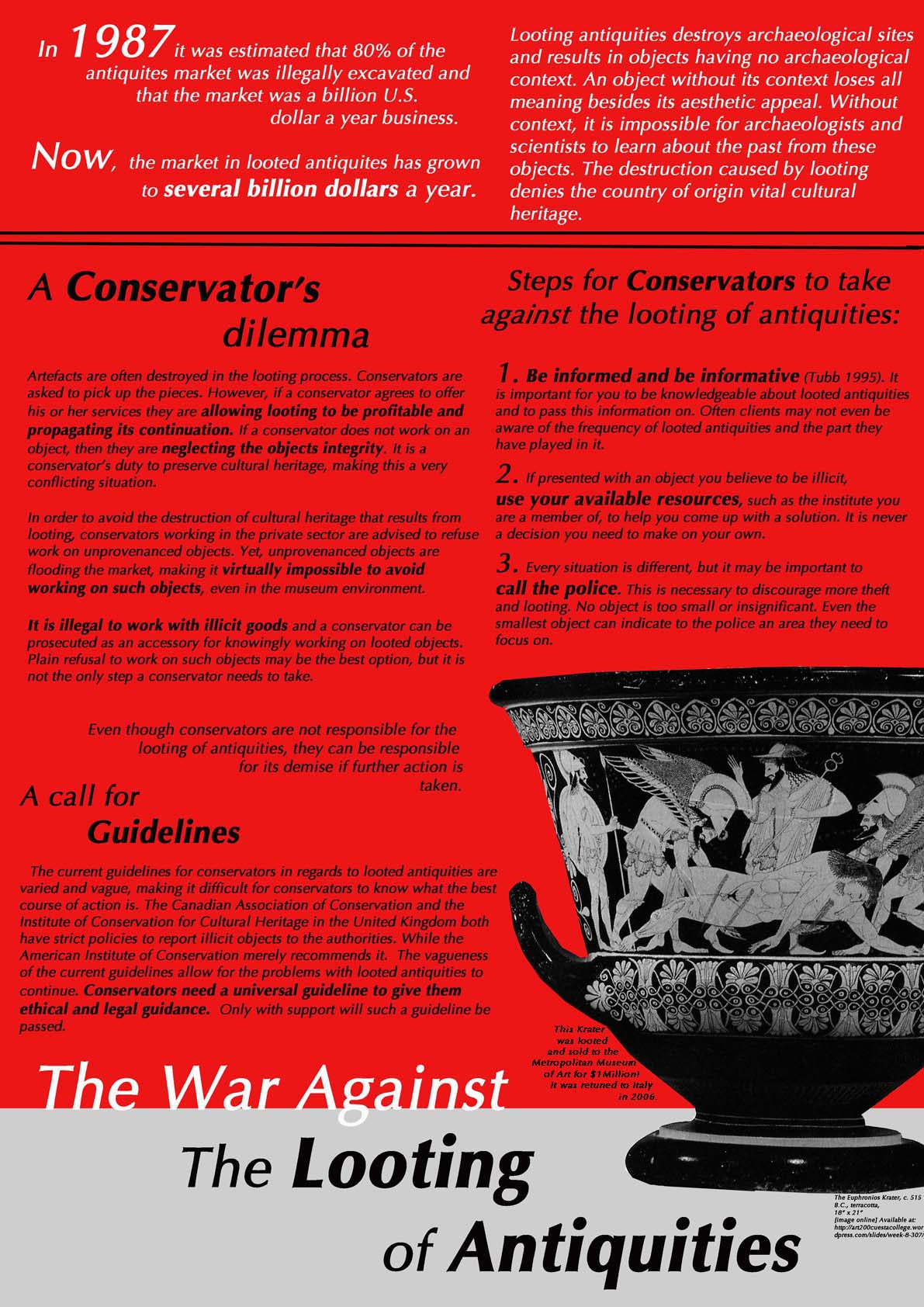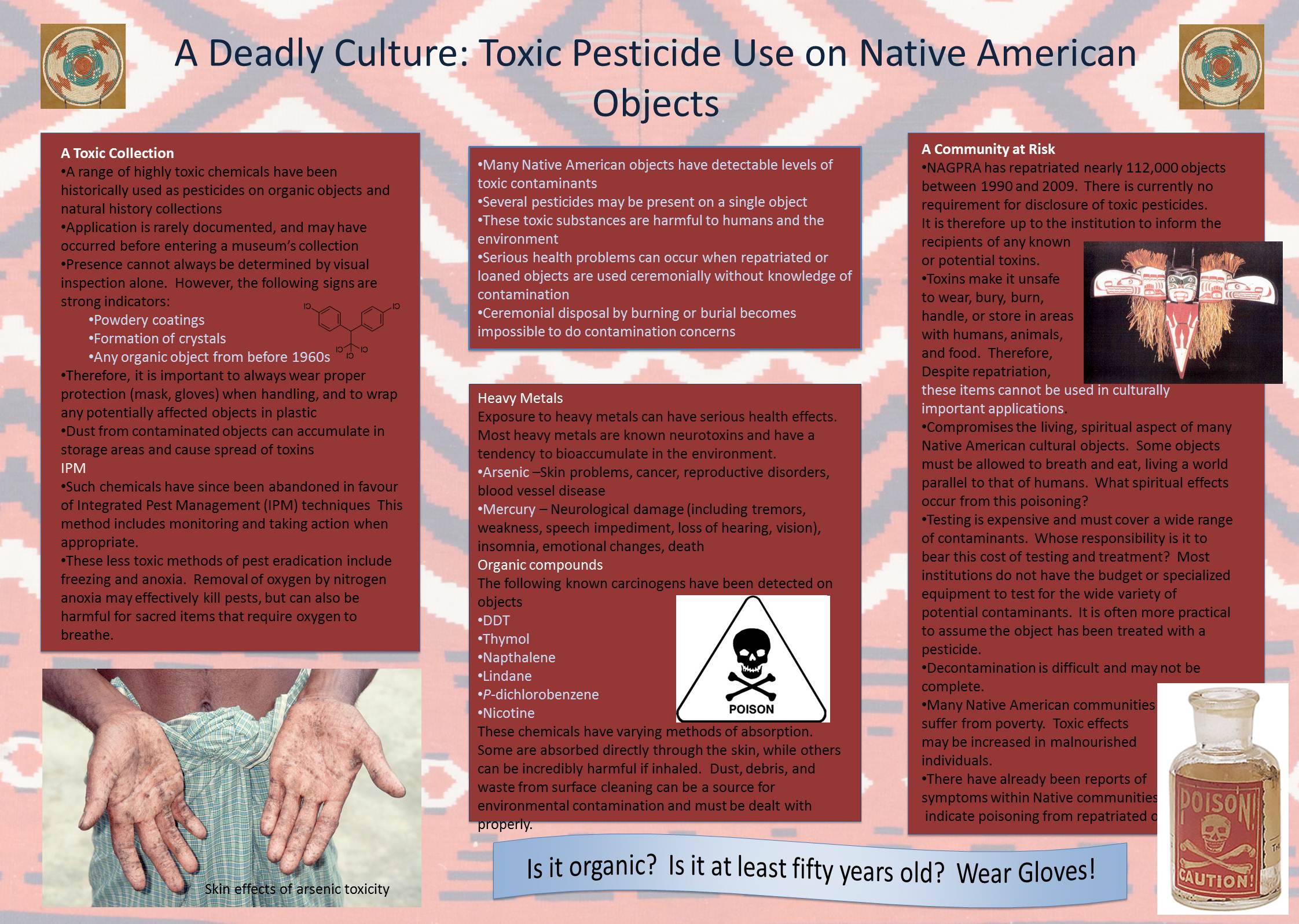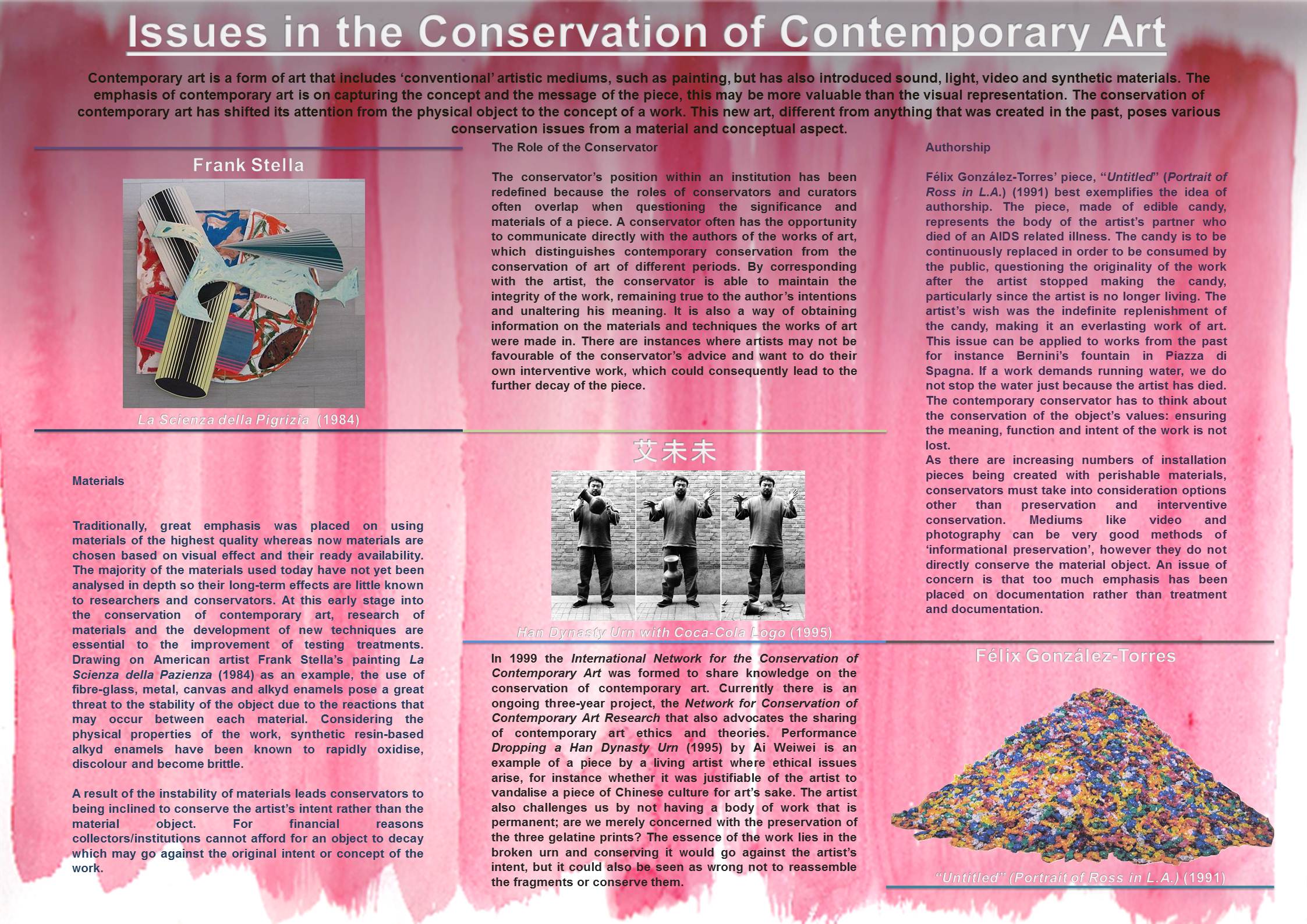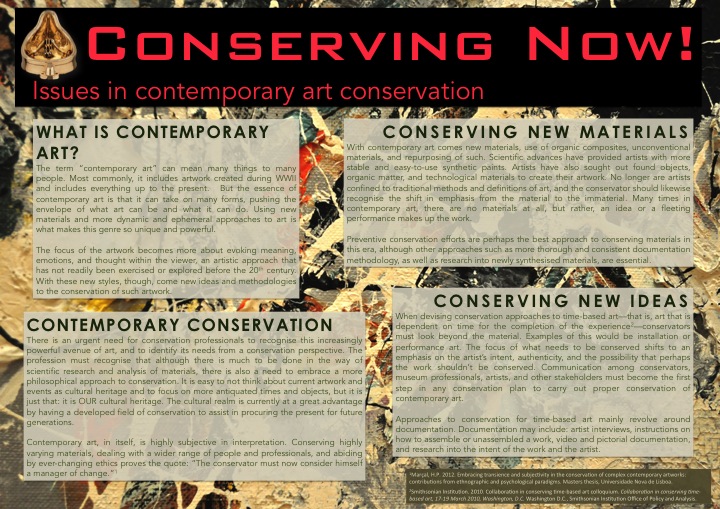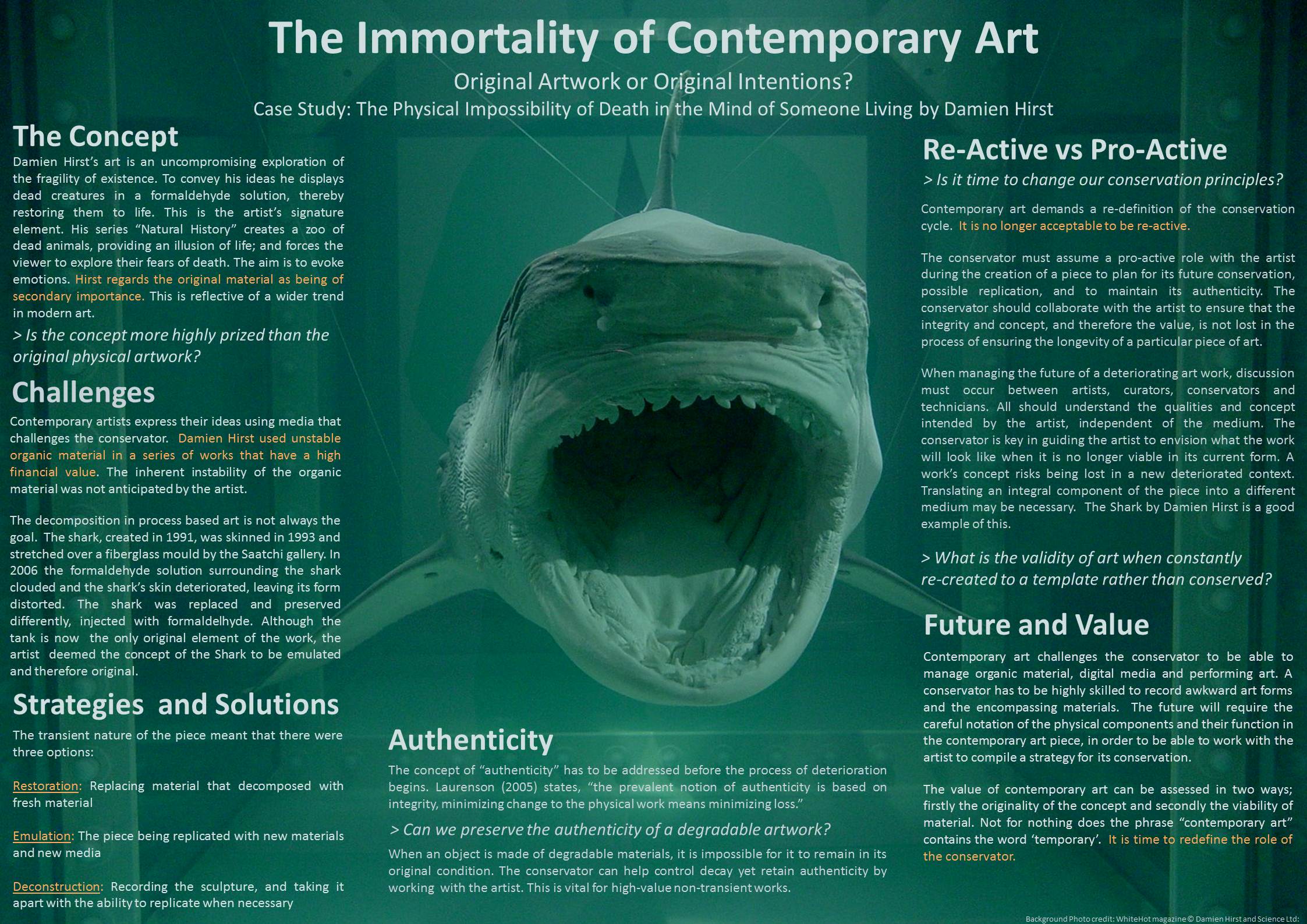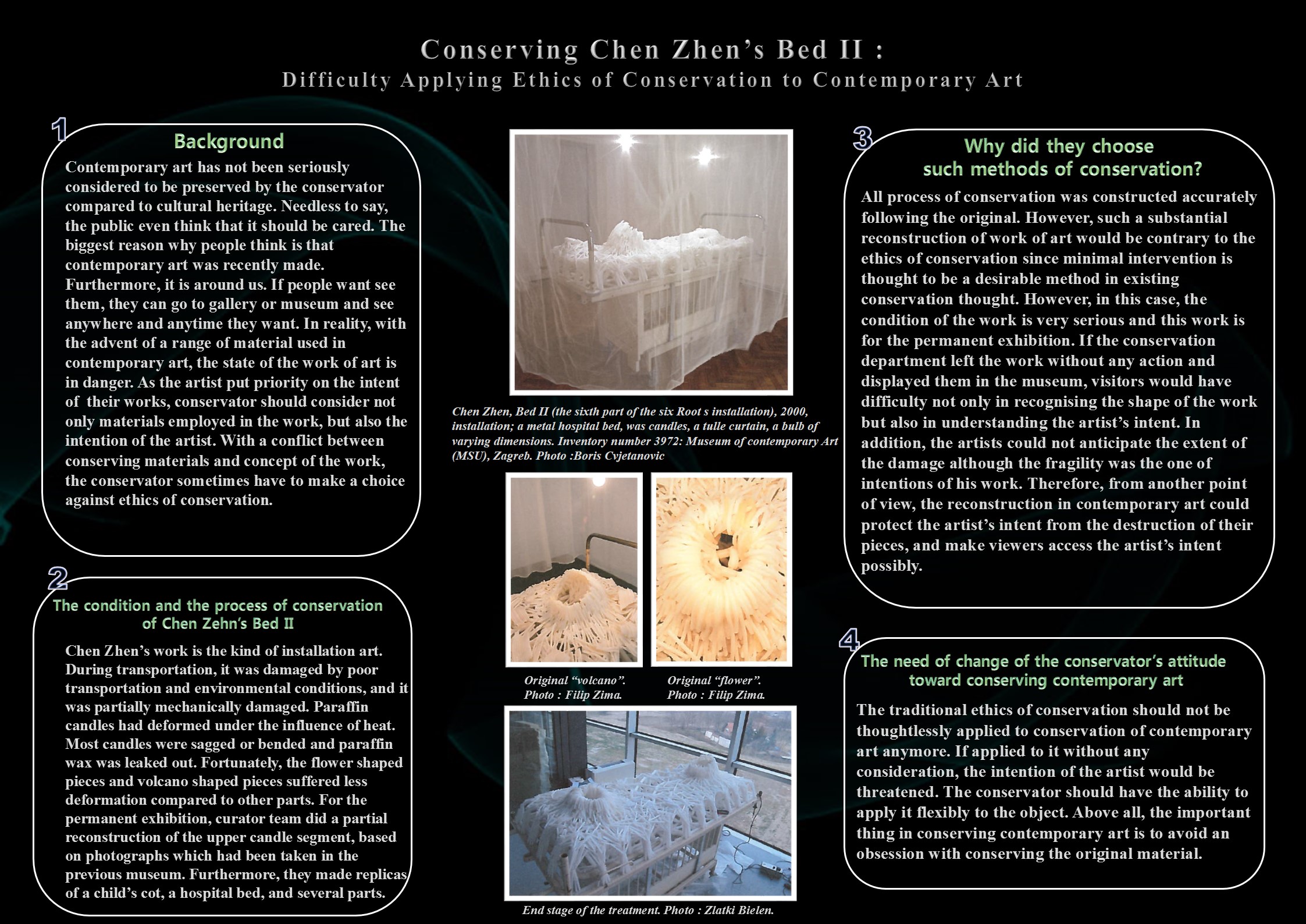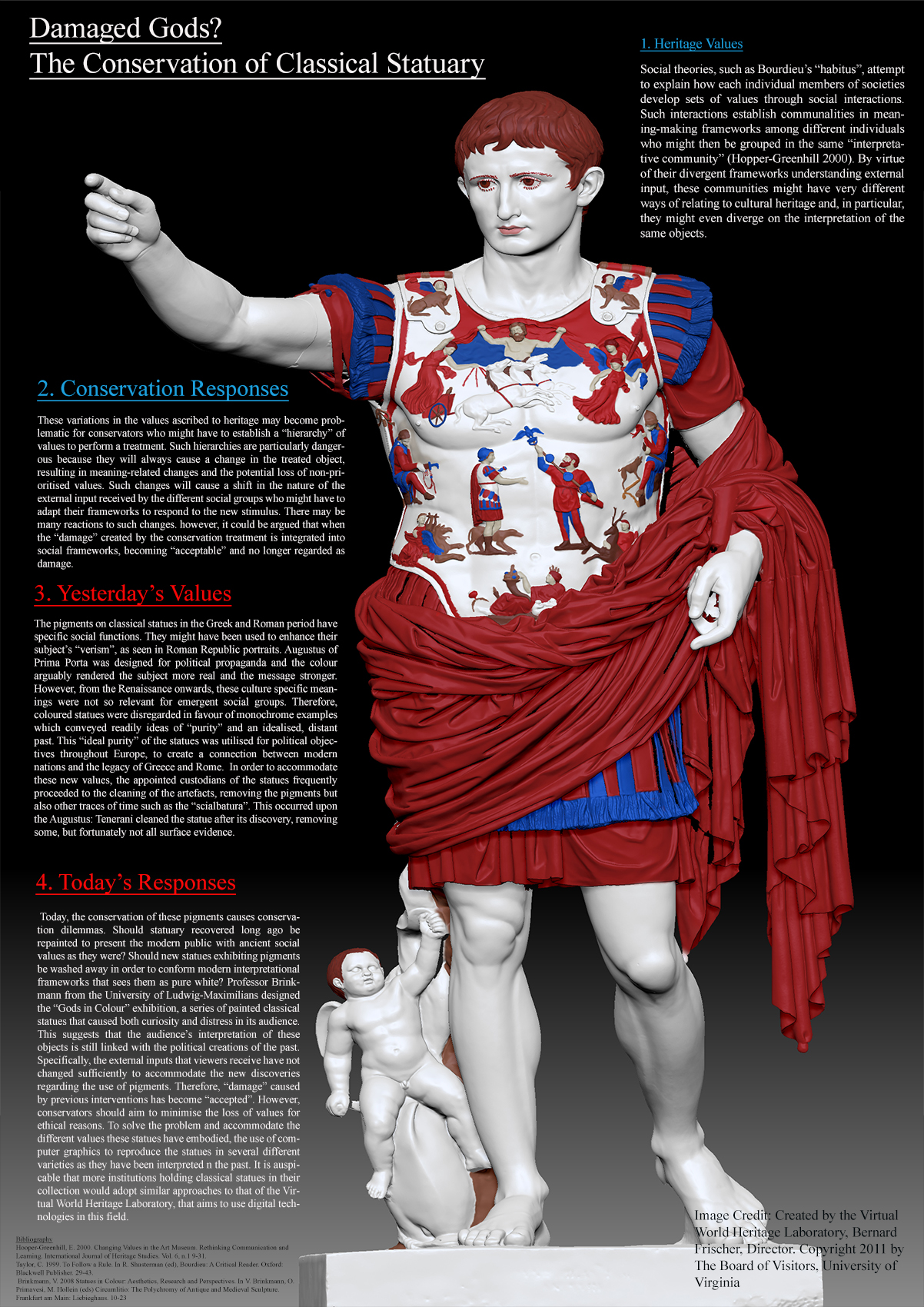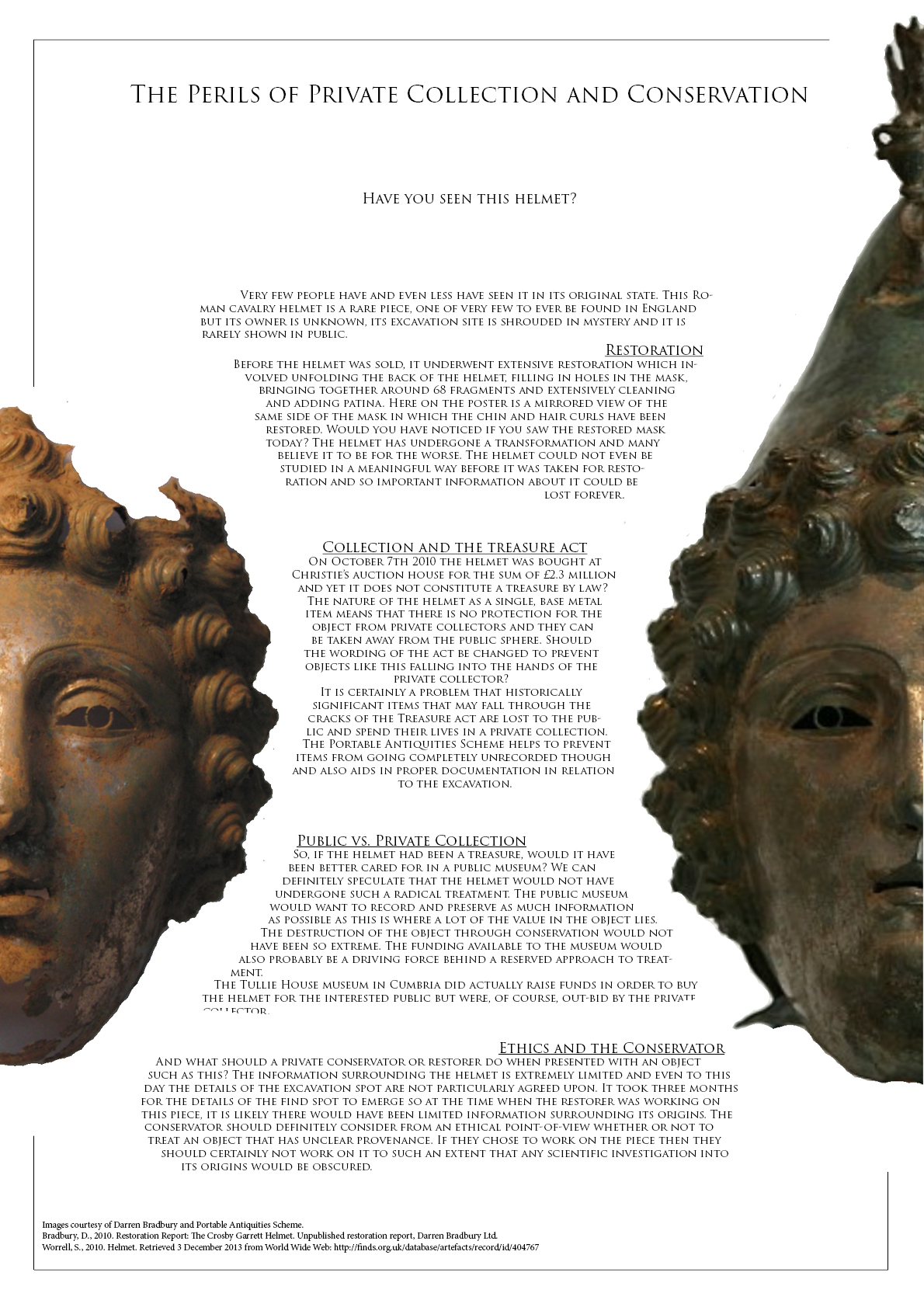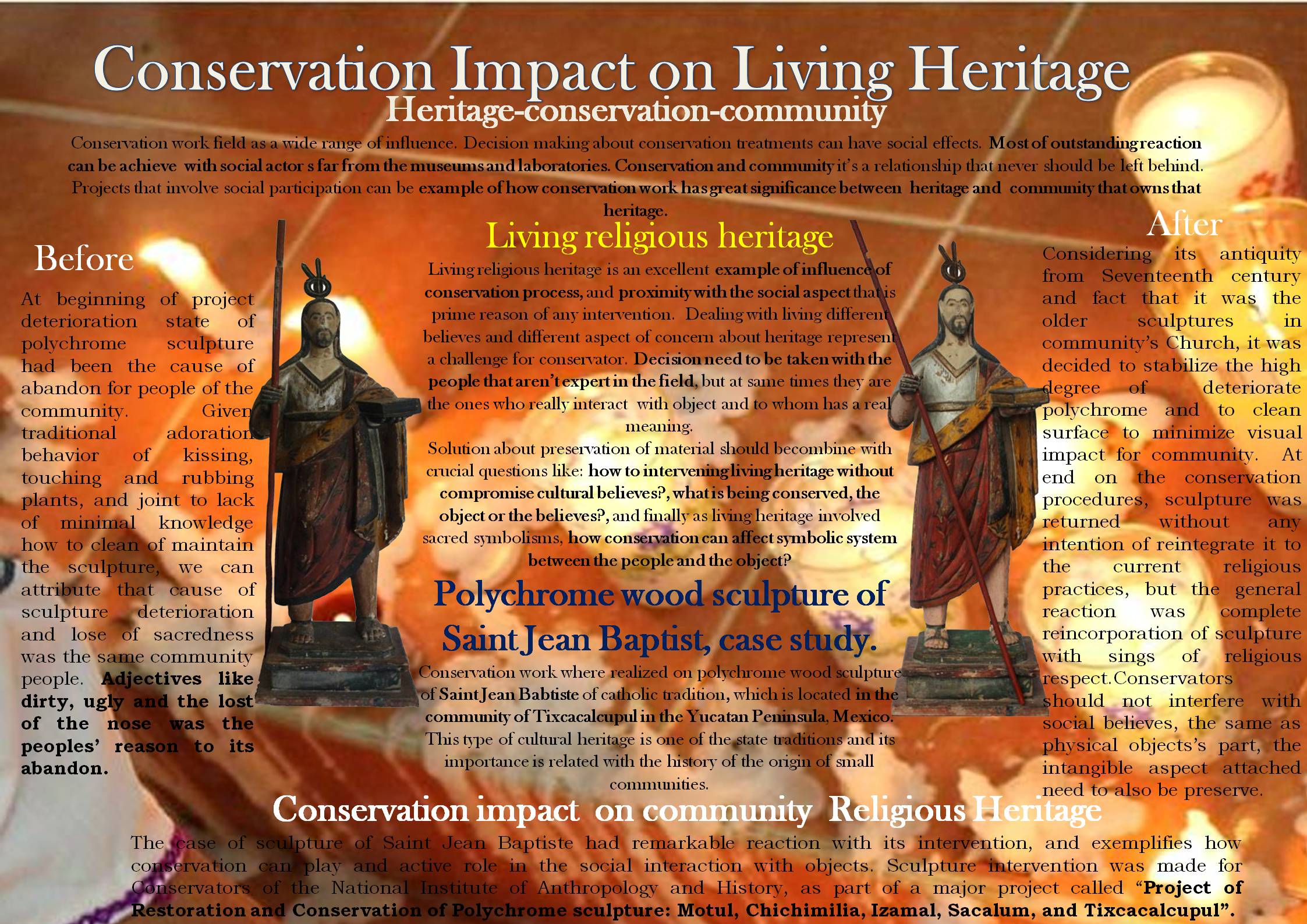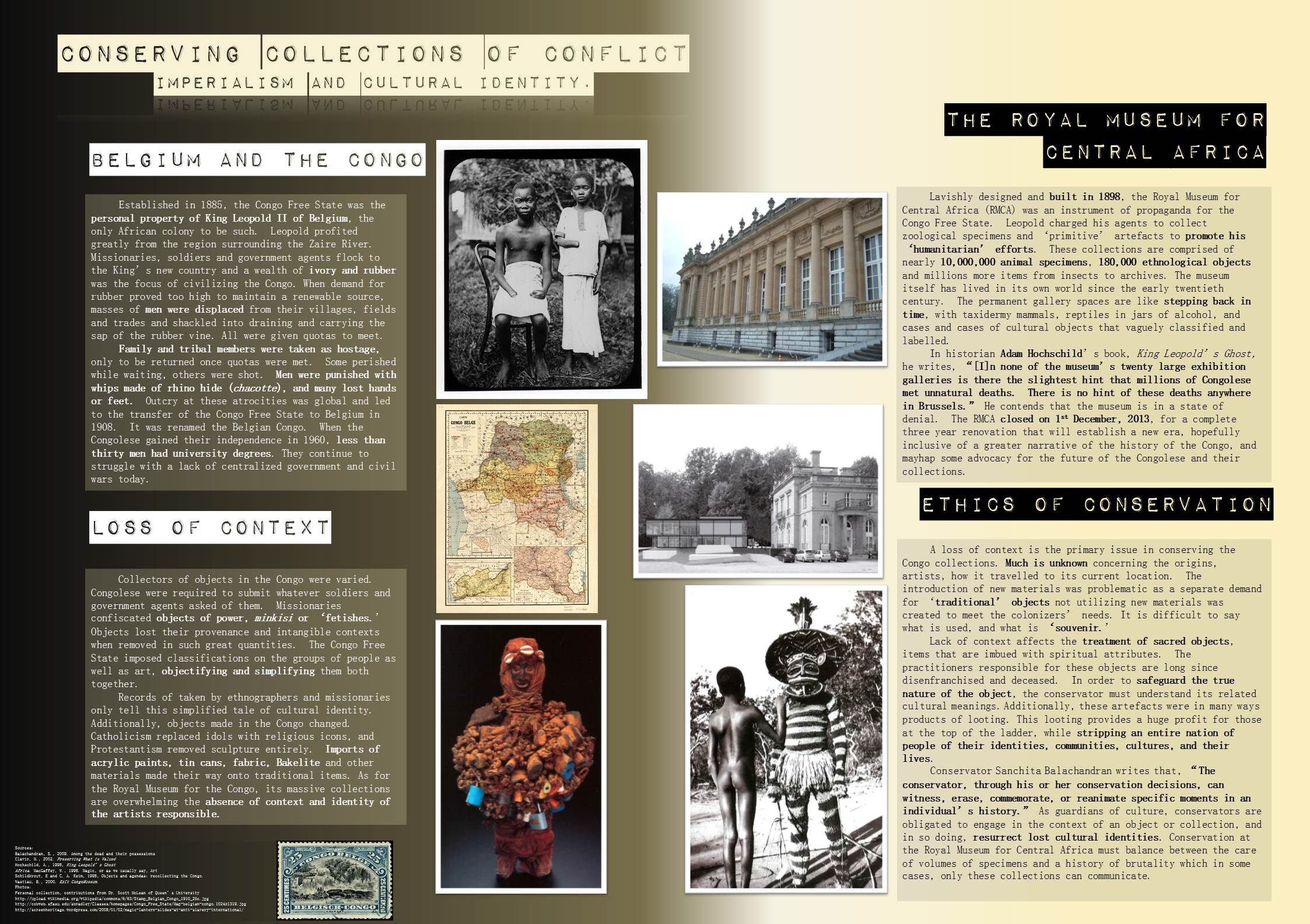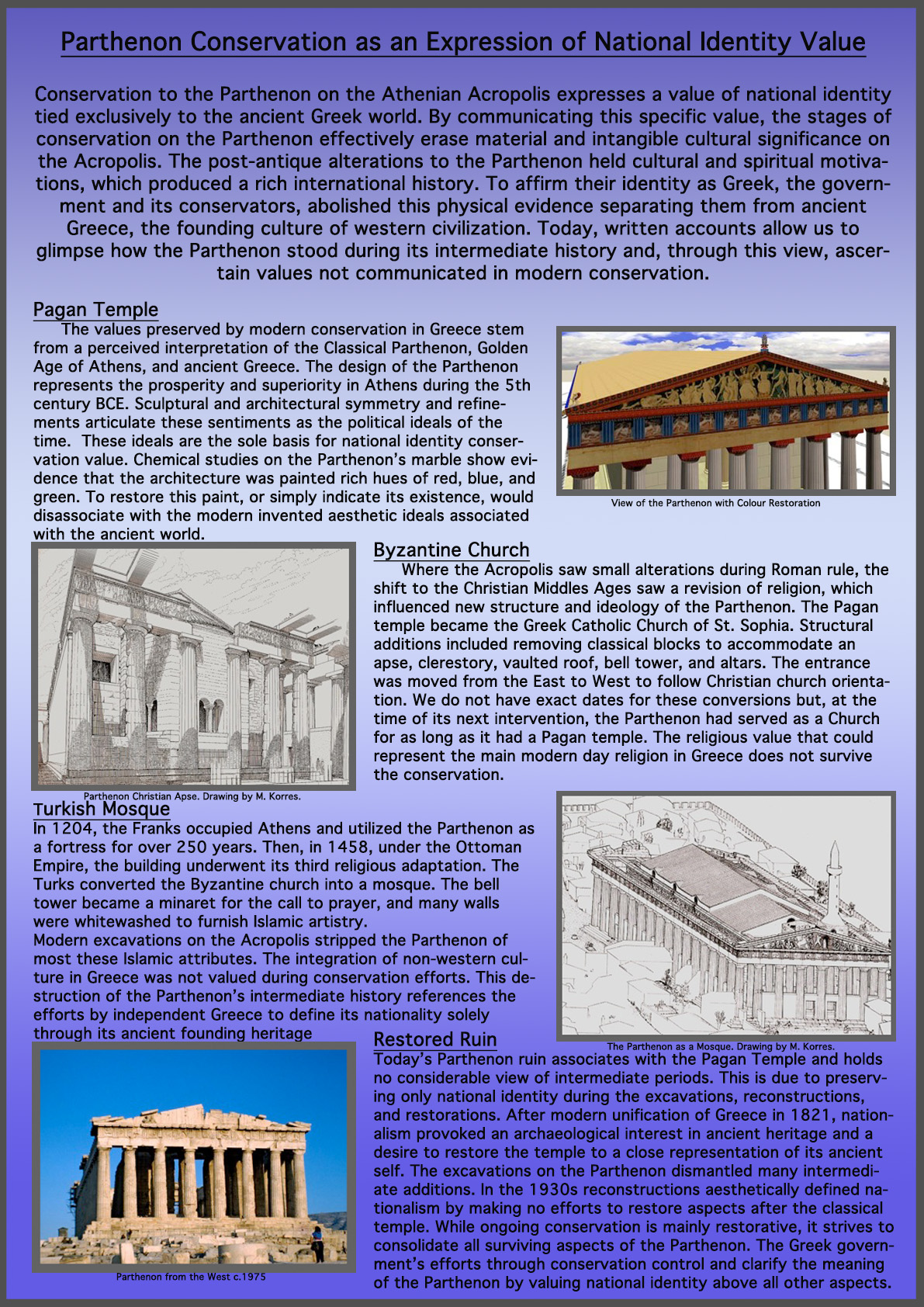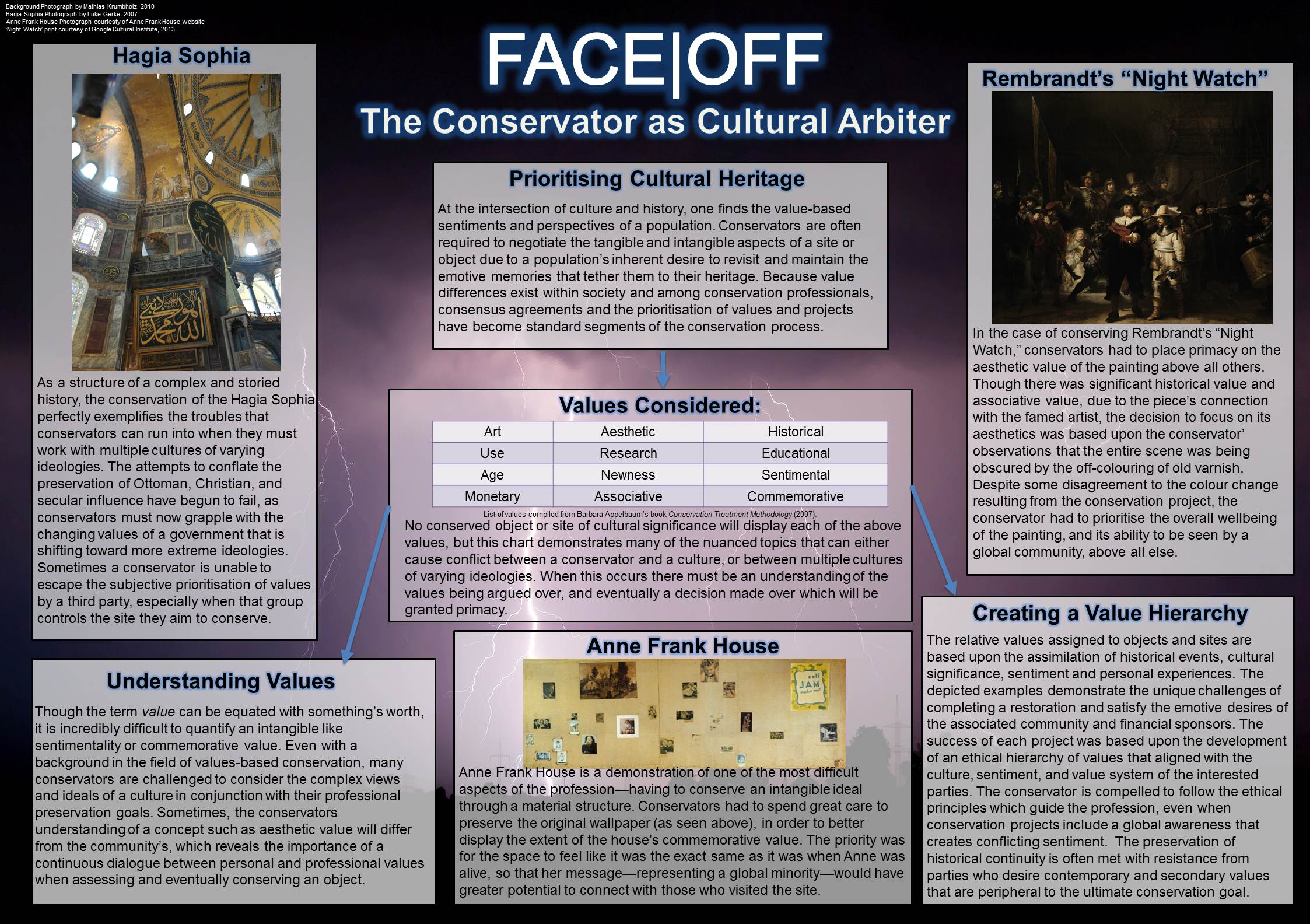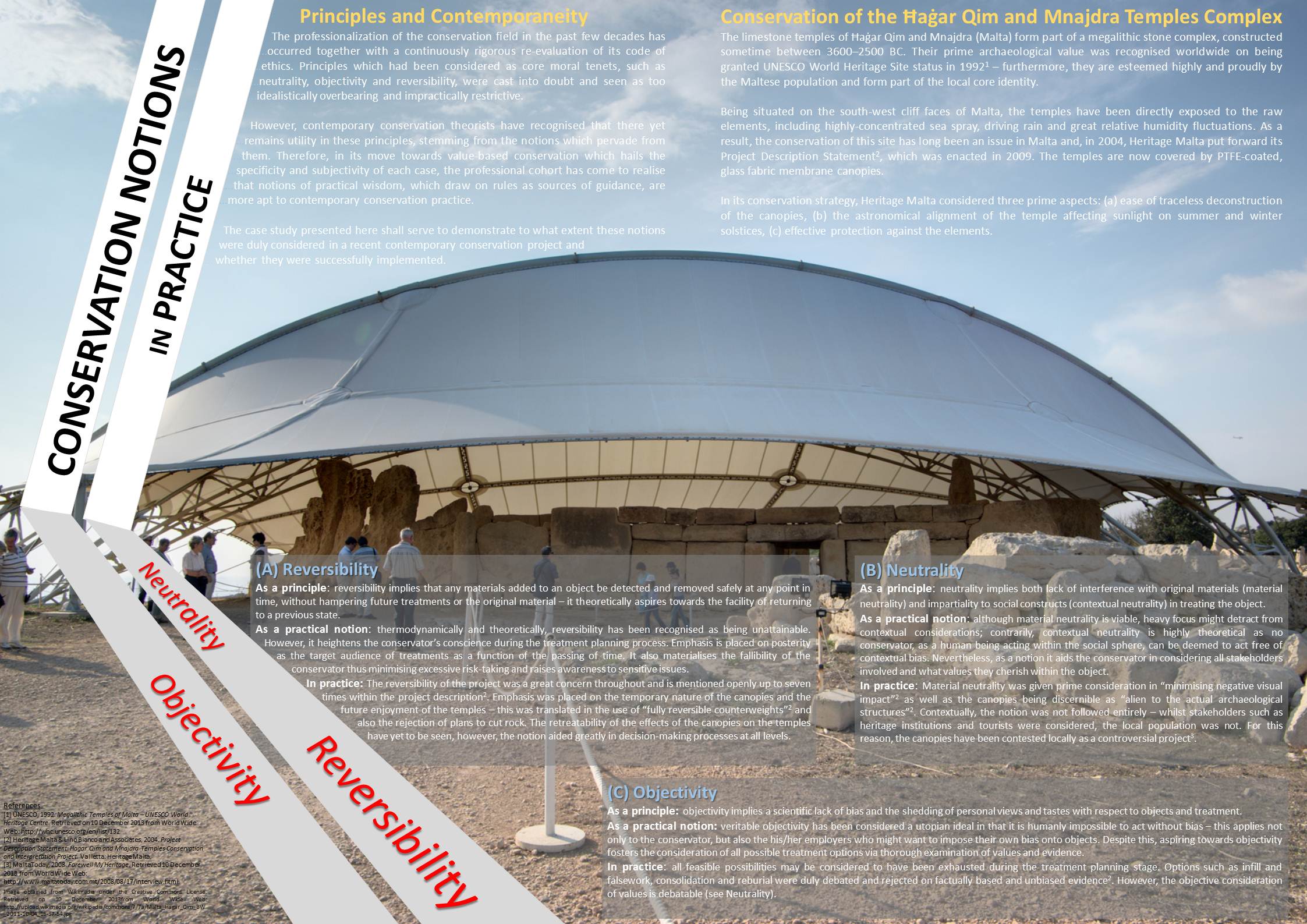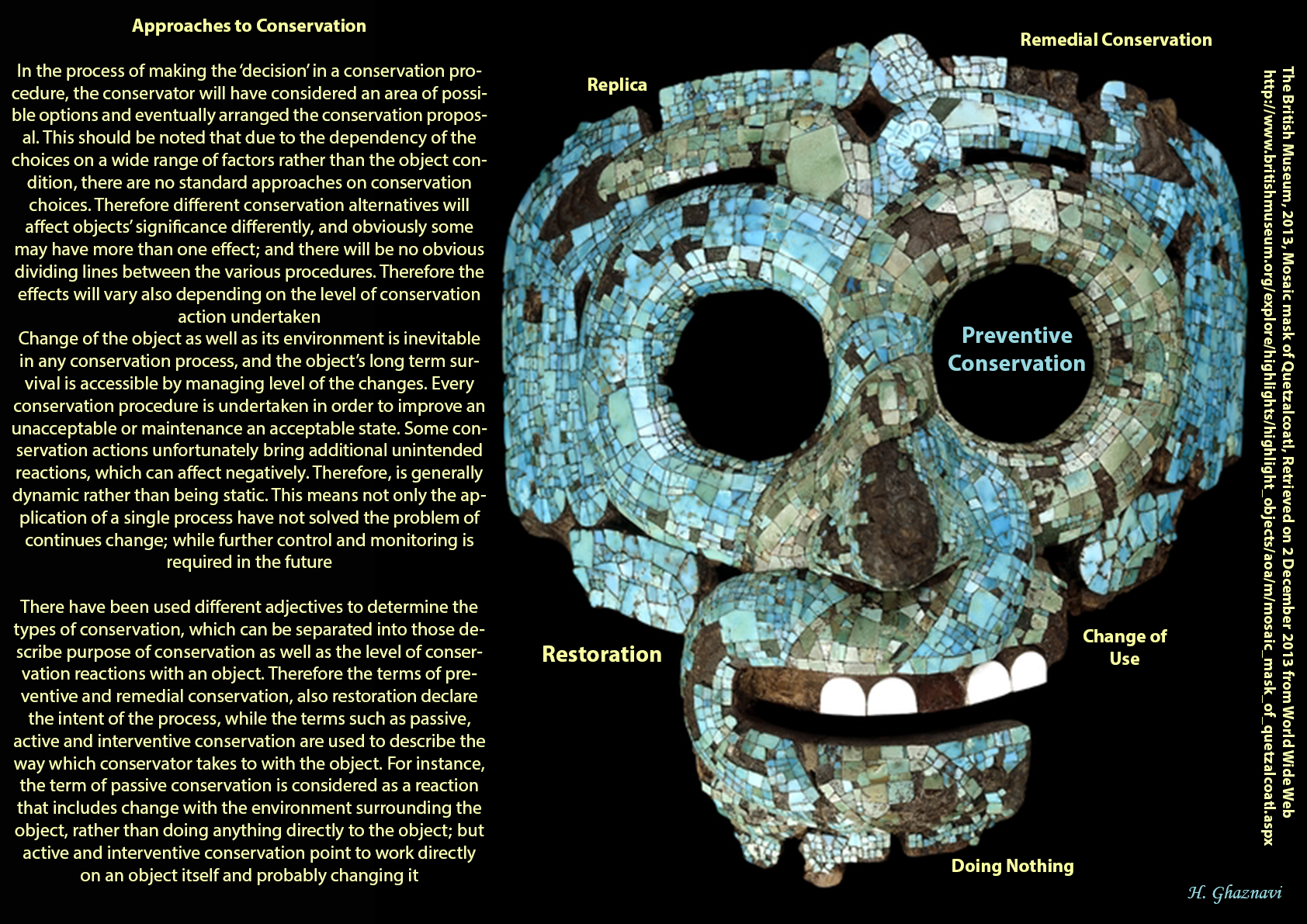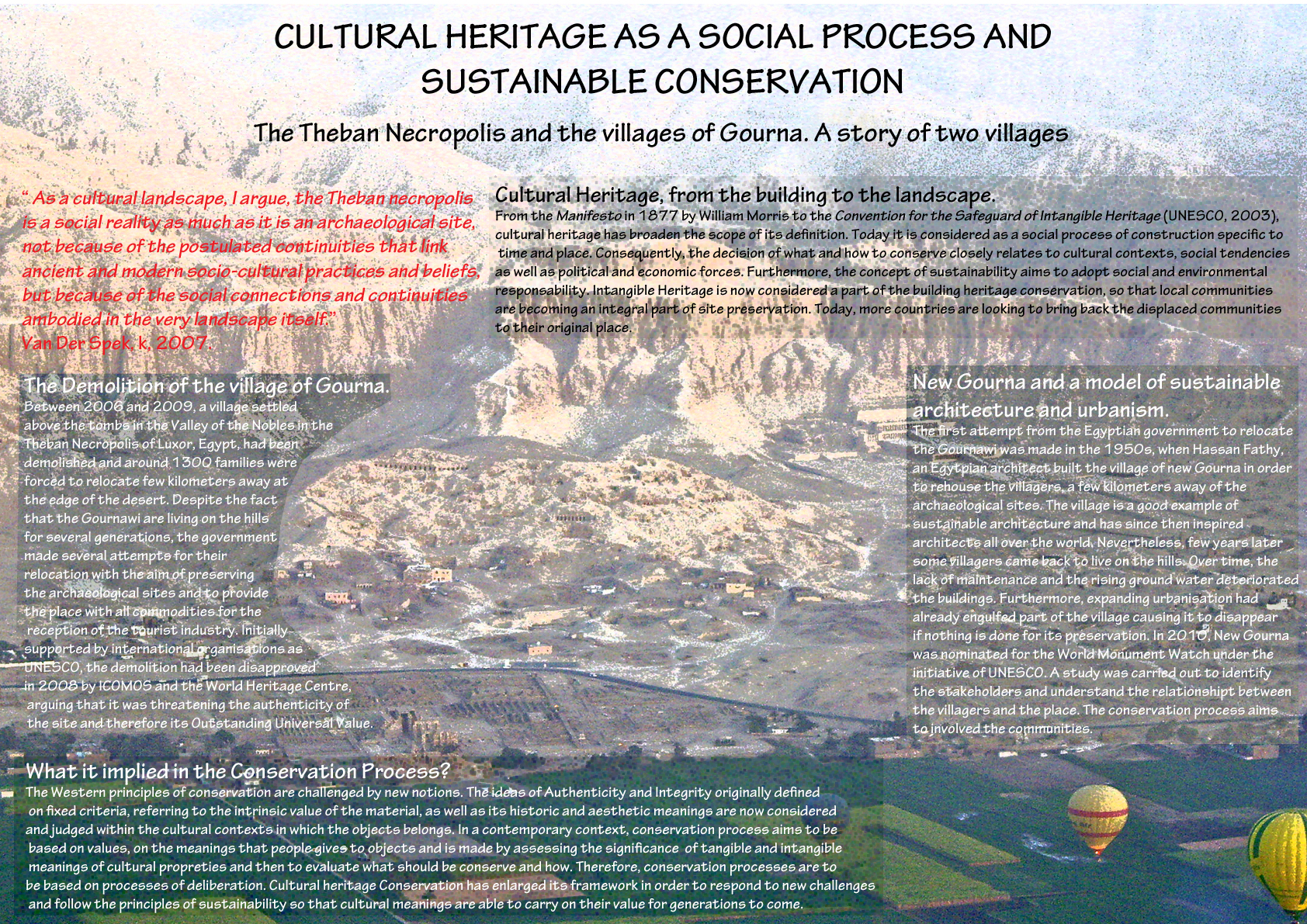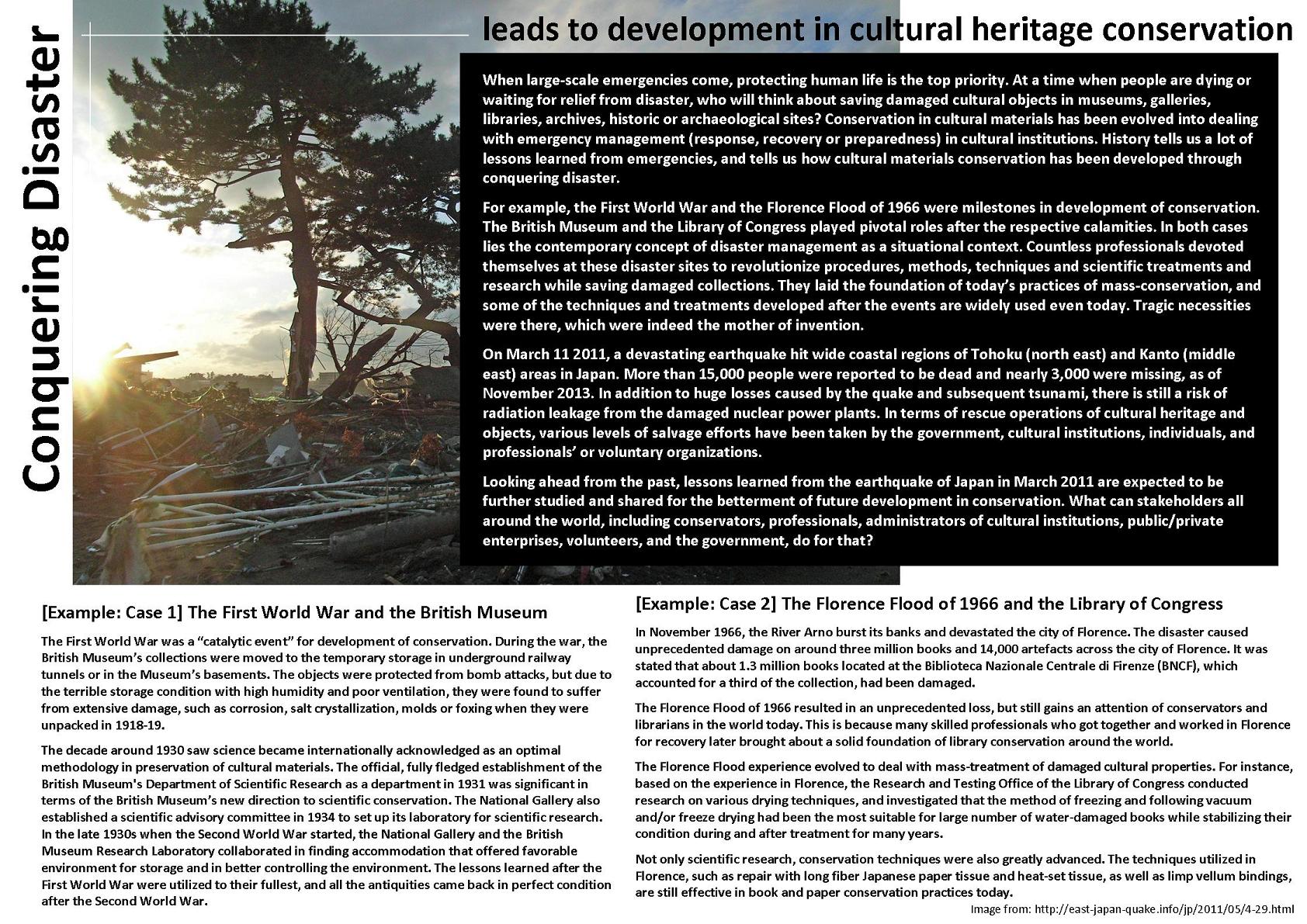 --Institute of Archaeology--
--Institute of Archaeology--
ARCLG141 Issues in Conservation: Contexts of Conservation Coordinator: R. Peters
ARCLG141 is one of the core courses of the MA in Principles of Conservation at the Institute of Archaeology, University College London. This course examines the nature and history of conservation of cultural heritage objects, and discusses practical, professional and ethical issues. It focuses on the role of conservation in museums and in disciplines such as archaeology and anthropology, and on the effects of political, cultural and institutional contexts on conservation practice.
This year students have explored a range of topics in their coursework including, but not limited to, participatory conservation, the conservation of looted and illicitly traded artefacts and the conservation of contemporary art, supervised by Renata Peters and Harald Fredheim. You can see some of their posters below. Note that their contents are the sole responsibility of their authors and and may not correspond to the views of the UCL Institute of Archaeology or any of the institutions they may happen to discuss. Student posters from previous years can be found here.
Working Together to Preserve Our Intangible Cultural Heritage through Cultural Centres. The Modern Museum (L. S.)The poster aims to bring awareness regarding the modernisation of the traditional museum by means of contemporary media using new innovative ways for intangible heritage to be presented to the public. It highlights the collaboration effort between Museum, Conservator and the Indigenous community and the important role in which the conservators assists in conserving intangible heritage. |
Helping to Restore More than Artefacts: Local Engagement in Conservation after the
|
Why is Participatory Conservation Important? (Y. Chock)Public participation is essential to decision-making in cultural heritage issues, and in recent years it has become an increasingly focal point of the conservation process. The poster outlines the benefits to be gained from participatory conservation, and lists possible methods in which conservators may engage the public to participate. The content is presented mainly from the standpoint of built heritage sites conservation, but the principles apply equally to all conservation specialisations. |
Why Should Participatory Conservation Matter to Me? (M. Narvey)Participatory conservation is often described as a process that is empowering for indigenous communities. However, conservators often describe their personal experiences with participatory conservation in a very positive light. Participatory conservation is more than a moral or political obligation for conservators – it makes us happier, and it makes us better at our jobs. |
“We Had More Because We Lived It”: The Dilemma of Intangible vs. Tangible Conservation for Native Peoples (S. Giffin)The conservation of tangible and intangible object values is a dilemma faced by many conservators and curators. While Western museums often focus on the tangible aspects of objects, indigenous communities many times stress the unseen intangible qualities of their heritage. Allowing for indigenous input in the preservation of their own heritage will hopefully help museums preserve both the physical objects and the cultural meanings behind them. |
Stay Away: Conservators and Ilicit Antiquities (A. Funke)Conservators are an inherent part of the heritage profession and should therefore be involved in the debate about unprovenanced antiquities. Although it may be difficult for conservators to avoid the treatment of such artefacts at this point, the improvement of education, transparency and accountability can lead to a better situation in the future. Conservators need to get involved with this topic as a profession and not leave the decision making process up to the individual. |
Conservator’s role in the black market of Underwater AntiquitiesThis poster demonstrates the conservator’s responsibility in the illegal import and export of archaeological objects from marine environments and the current efforts to prevent the illicit trade of marine artifacts that have been looted. The case study of the Dodington coins is the most well-known example of this trade and is used as a reference point. The goal of the poster is to make conservators more vigilant regarding this issue. |
The role of the conservator in the illicit trade of antiquities (P. Torres)The poster expresses the opinion that conservators who conserve unprovenienced antiquities are not being any different from criminals who perform conservation techniques on the artefacts they illegally obtain. The poster also expresses the damage that can be done to the archaeological record by conservators who engage in the conservation of unprovenience artefacts. |
The War Against the Looting of Antiquities (A. Duckor)The looting of antiquities is a growing problem that has transformed into a multi-billion dollar a year business. By working on looted antiquities, conservators are perpetuating the illicit market by providing it with valuable objects. However, refusing to work on looted antiquities may mean a conservator is neglecting his or her duty to preserve cultural heritage. This poster outlines the steps a conservator needs to take when confronted with an illicit object and it calls for an ethical guideline to be produced. |
A Deadly Culture: Toxic Pesticide Use on Native American Objects (N. Frankel)Historically, organic objects in museum collections have been treated with a variety of highly toxic pesticides. This includes most Native American objects, which may be handled and used ceremonially while on loan or after repatriation. Not only does this raise serious health and environmental concerns, but it also may affect the spiritual value of the object. |
Issues in the Conservation of Contemporary Art (E. Williams)The conservation of contemporary art is an important topic because it is the art that reflects our society. Art comes in all forms nowadays, and it includes works like installation and performance. Looking at the materials, although the art is very recent, it has already begun to decay. When it is not the object’s materials that are unstable, it is the conservation of the concept or intent of the work that needs to be conserved. |
Conserving Now! (K. K.)For contemporary art, there is an increased emphasis on the ideology of the artwork, in addition to the use unconventional materials. This approach to art is relatively new, and for the conservator it may pose philosophical, ethical, as well as scientific conundrums. This paper aims to dissect some of the issues that arise from the prospect of conserving contemporary art, including dealing with synthesized materials, ephemeral materials, and addressing possible approaches to conserving the intangible side of contemporary art. | The Immortality of Contemporary Art, Original Artwork or Original Intentions? (L. S.)The multi media that Contemporary Artists use to express their ideas challenge established conservation principles. The material used to manifest the original concept is often unstable and the physical piece has a short shelf life or ‘see by date’. The Artist intended permanence of the idea. The purchaser has assumed long term investment of an object. The conservator must claim membership of the Artists ‘studio support team’. A new paradigm is required to define the modus operandi of the conservator. |
Conserving Chen Zhen’s Bed II :Difficulty Applying Ethics of Conservation to Contemporary Art (Y. Y.)Most contemporary art is vulnerable. Due to the wide diversity, and often mutual incompatibility of employed materials, the preservation of contemporary art collections is technically difficult. More complicated problem is the understanding the relationship between the idea and material of the work. With a conflict between conserving materials and concept of work, the conservator sometimes have to make a choice against ethics of conservation. |
Issues relating to the conservation of wall paintings in the Tomb of Amenophis III:
|
Damaged Gods? The Conservation of Classical Statuary. (I. Capasso)This poster aims to describe the relationship between external factors and conservation. Such a connection is structured as feedback loop: external factors prompting certain conservation treatments that might change the set of values linked with heritage, thus calling for different treatments in the future. Such a framework was adopted to examine the case of the conservation of classical statuary in order to specifically analyse the social responses attached to it today. |
Understanding the Effects of Collection Method on Conservation (E. Frank)The poster illustrates a theoretical framework for understanding the affects of collection method on conservation. The use of this framework is illustrated by case study of the Northwest Coast Totem Pole collection at the American Museum of Natural History (AMNH). Thanks to Judith Levinson and the conservation department at AMNH for allowing the use of relevant unpublished treatment reports. |
The Perils of Private Collection and Conservation. (J. M.)This poster explores the issues arising from the private collection of objects and how that can affect the conservator. The discussion is based around the case study of the Crosby Garrett helmet, the reasons behind it being privately collected and the effects this has had on the object. |
Conservation Impact on Living heritage. (E. Q.)Conservations decisions can have outstanding impacts between the social systems of meaning, uses and functions applied to objects through peoples social believes. Work with the tangible sphere of objects can also allow interfering with the intangible aspects, and this can only have true meaning through the society. Examples of the impact that conservation may have can be seen more clearly through work with living heritage and communities. |
Conserving Collections of Conflict: Imperialism and Cultural Identity (K. Gillette)The Royal Museum for Central Africa in Belgium houses one of the most varied collections of zoological specimens and cultural artefacts from the Congo. The collection, however, was compiled through the brutality of the Belgian colonization of the Congo. This poster narrates the foundational history and causes for the loss of context in Congolese objects and offers observations on why and how a conservator should address this collection’s context. |
Parthenon Conservation as an Expression of National Identity Value (L. G.)This poster outlines some of the interventions made to the Parthenon in Athens after the 5th century BCE and how the many conservation measures on the monument in modern times do not reflect this intermediate history. The excavations, reconstructions, and restorations beginning in the 19th century express the value of national identity above all other cultural significances. |
Face|Off: The Conservator as Cultural Arbiter (V. Applebaum)Conservation professionals must assimilate varying values to ensure their work reflects respect for the identity of the community who claims ownership of an object or site. While circumstances and issues can differ for a conservator, the results of their work are a demonstration of the tenuous compromise between professional and personal values. Competing and conflicting values of aesthetics, commemoration and political sensitivity become part of the conservator's arbitration, especially when dealing with sensitive subjects such as cultural heritage and identity. | Conservation Notions in Practice: Neutrality, Objectivity, Reversibility (J. Cutajar)The professionalization of conservation has occurred contemporaneously with a continuous re-evaluation of its code of ethics – by looking at these principles more as flexible notions of practical wisdom, their attainability and use within the profession is considered and applied to the conservation of the Ħaġar Qim and Mnajdra Temples in Malta. |
||
Approaches to Conservation (H. Ghaznavi)Having a brief look at evolution of the field of conservation indicates that the changing approaches to conservation have always been considered as one of the controversial issues in the field of heritage preservation, which there is no specific standard approach yet. In addition, the issue carries valuable discussions in regards to various factors influencing conservation reaction. Therefore, the matter valuably costs further conversations and communications within a professional society. |
Cultural Heritage as a Social Process and Sustainable Conservation (C. d'I.-G.)The aim of the poster is to highlight through a case study the evolution in the conception of cultural heritage as a social process and how it led to the idea of sustainable conservation. Therefore the notion of authenticity and integrity which are the basis of the conservation practice evolve to be considered in the context in which the cultural property belongs and so influence the conservation process. |
Conquering Disaster Leads to Development in Cultural Heritage Conservation (S. Tokuda)In cultural heritage conservation, the First World War and the Florence Flood of 1966 were milestones of its |
|
|
